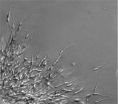(Press-News.org) Interneurons – nerve cells that function as 'dimmers' – play an important role in the brain. Their formation and migration to the cerebral cortex during the embryonic stage of development is crucial to normal brain functioning. Abnormal interneuron development and migration can eventually lead to a range of disorders and diseases, from epilepsy to Alzheimer's. New research by Dr. Eve Seuntjens and Dr. Veronique van den Berghe of the Department of Development and Regeneration (Danny Huylebroeck laboratory, Faculty of Medicine) at KU Leuven (University of Leuven) has identified two proteins, Sip1 and Unc5b, that play an important role in the development and migration of interneurons to the cerebral cortex – a breakthrough in our understanding of early brain development.
Two types of nerve cells are crucial to healthy brain functioning. Projection neurons, the more widely known of the two, make connections between different areas of the brain. Interneurons, a second type, work as dimmers that regulate the signalling processes of projection neurons. A shortage or irregular functioning of interneurons can cause short circuits in the nervous system. This can lead to seizures, a common symptom of many brain disorders. Interneuron dysfunction even appears to play a role in schizophrenia, autism and neurodegenerative diseases such as Alzheimer's, Parkinson's and ALS.
Trailblazers
Researchers have only recently understood how different kinds of neuron are formed during embryonic development. During early brain development, stem cells form projection neurons in the cerebral cortex. Interneurons are made elsewhere in the brain. These interneurons then migrate to the cortex to mix with the projection neurons. Dr. Eve Seuntjens of the Celgen laboratory led by Professor Danny Huylebroeck explains: "The journey of interneurons is very complex: their environment changes constantly during growth and there are no existing structures — such as nerve pathways — available for them to follow."
The question is how young interneurons receive their 'directions' to the cerebral cortex. Several proteins play a role, says Dr. Seuntjens. "We changed the gene containing the production code for the protein Sip1 in mice so that this protein was no longer produced during brain development. In those mice, the interneurons never made it to the cerebral cortex — they couldn't find the way.
That has to do with the guidance signals – substances that repel or attract interneurons and thus point them in the right direction – encountered by the interneurons on their way to the cerebral cortex. Without Sip1 production, interneurons see things through an overly sharp lens, so to speak. They see too many stop signs and become blocked. That overly sharp lens is Unc5b, a protein. Unc5b is deactivated by Sip1 in healthy mice. There are several known factors that influence the migration of interneurons, but Unc5b is the first protein we've isolated that we now know must be switched off in order for interneuron migration to move ahead smoothly."
The next step is to study this process in the neurons of humans. "Now that there are techniques to create stem cells from skin cells, we can mimic the development of stem cells into interneurons and study what can go wrong. From there, we can test whether certain drugs can reverse the damage. That's all still on the horizon, but you can see that the focus of research on many brain disorders and diseases is increasingly shifting to early child development because that just might be where a cause can be found."
INFORMATION:
Contacts:
Dr. Eve Seuntjens
KU Leuven
Faculty of Medicine
Department of Development and Regeneration
Embryo and Stem Cell Unit
Prof. Danny Huylebroeck
KU Leuven
Faculty of Medicine
Department of Development and Regeneration
Embryo and Stem Cell Unit
tel. 32-163-731-39
e-mail danny.huylebroeck@med.kuleuven.be
Dr. Veronique van den Berghe
Faculty of Medicine
Department of Development and Regeneration
Embryo and Stem Cell Unit
tel. 32-163-731-35
e-mail veronique.vandenberghe@med.kuleuven.be
More information:
View the online version of this release at: http://www.kuleuven.be/english/news/protein-identified-that-can-disrupt-embryonic-brain-development-and-neuron-migration.
The full text of the study 'Directed migration of cortical interneurons depends on the cell-autonomous action or Sip1' is available on the website of Neuron:
www.sciencedirect.com/science/article/pii/S0896627312010008.
Protein identified that can disrupt embryonic brain development and neuron migration
New research uncovers role of two proteins, Sip1 and Unc5b, in the development and migration of interneurons to the cerebral cortex -- a breakthrough in our understanding of early brain development.
2013-01-14
ELSE PRESS RELEASES FROM THIS DATE:
Research makes connetion between tubal ligation and increase in cervical cancer rates
2013-01-14
Women who have a tubal ligation – the surgical tying or severing of fallopian tubes to prohibit pregnancy – have less frequent Pap smears, which puts them at an increased risk for cervical cancer, according to research recently released by a team that included Cara A. Mathews, MD, a gynecologic oncologist at the Program in Women's Oncology at Women & Infants Hospital of Rhode Island.
The findings were part of the National Cancer Institute-funded study "Study to Understand Cervical Cancer Endpoints and Determinants" being conducted when Dr. Mathews was a fellow at the ...
Liver controls wasting in cancer
2013-01-14
Cachexia or wasting is a condition affecting up to 70 percent of cancer patients, depending on the type of cancer. It is characterized by a dramatic loss of body weight that is independent of food intake. Cachexia is seen particularly often and most pronounced in patients suffering from cancers of the digestive tract and the lungs. They may lose up to 80 percent of body fat and skeletal muscle. Muscle loss leads to weakness and immobility of patients and poorer response to treatment. An estimated 20 percent of cancer deaths are considered to be a direct consequence of cachexia, ...
Dynamic, dark energy in an accelerating universe
2013-01-14
This press release is available in Spanish.
It was cosmology that drew Irene Sendra from Valencia to the Basque Country. Cosmology alsogave her the chance to collaborate with one of the winners of the 2011 Nobel Prize for Physics on one of the darkest areas of the universe. And dark matter and dark energy, well-known precisely because so little is known about them, are in fact the object of the study bySendra, a researcher in the Department of Theoretical Physics and History of Science of the UPV/EHU's Faculty of Science and Technology.
"Observations tell us that ...
NRL designs multi-junction solar cell to break efficiency barrier
2013-01-14
WASHINGTON -- U.S. Naval Research Laboratory scientists in the Electronics Technology and Science Division, in collaboration with the Imperial College London and MicroLink Devices, Inc., Niles, Ill., have proposed a novel triple-junction solar cell with the potential to break the 50 percent conversion efficiency barrier, which is the current goal in multi-junction photovoltaic development.
"This research has produced a novel, realistically achievable, lattice-matched, multi-junction solar cell design with the potential to break the 50 percent power conversion efficiency ...
Using lysine estimates to detect heat damage in DDGS
2013-01-14
URBANA – Distillers dried grains with solubles (DDGS) are a good source of energy and protein in swine diets. However, they can be damaged by excessive heat during processing, compromising their nutritional value. University of Illinois researchers have found that it is possible to assess heat damage by predicting the digestibility of lysine in DDGS.
Excessive heat causes some of the lysine in DDGS to bond with sugars and form Amadori compounds. The lysine bound in these compounds is called unreactive lysine; pigs cannot digest it. Lysine that is not bound is referred ...
Amino acid studies may aid battle against citrus greening disease
2013-01-14
This press release is available in Spanish.Amino acids in orange juice might reveal secrets to the successful attack strategy of the plant pathogen that causes citrus greening disease, also known as Huanglongbing or HLB. Studies of these amino acids by U.S. Department of Agriculture (USDA) chemist Andrew P. Breksa III and University of California-Davis professor Carolyn M. Slupsky may pave the way to a safe, effective, environmentally friendly approach to undermine Candidatus Liberibacter asiaticus, the microbial culprit behind HLB.
The scientists used nuclear magnetic ...
ASH international clinical collaboration replicates high cure rate of APL in developing countries
2013-01-14
(WASHINGTON) – Data published online today in Blood, the Journal of the American Society of Hematology (ASH) describe the work of an ASH international clinical network collaborative focused on modernizing treatment protocols for patients in the developing world with acute promyeloctyic leukemia (APL) that has drastically improved cure rates in patients in Central and South America, achieving comparable outcomes to those observed in patients in the United States and in Europe.
APL is a rare, aggressive cancer of the blood and bone marrow that can be fatal in a matter ...
Better care from doctors who are culturally aware
2013-01-14
HIV patients from ethnic minorities receive better quality of care from doctors and other primary healthcare professionals who are the most competent at caring for patients from diverse backgrounds – those who are "culturally competent." These patients also tend to manage both their treatment and condition better, according to a new study¹ by Somnath Saha from Portland VA Medical Center, and the Oregon Health & Science University in the US, and colleagues. Their findings appear in the Journal of General Internal Medicine², published by Springer.
The authors explored whether ...
The secret sex life of the penicillin-producing fungus could make it more productive
2013-01-14
New and more effective strains of the fungus used to produce penicillin could be developed after a team of international scientists unearthed the secret sex life of Sir Alexander Fleming's fungus Penicillium chrysogenum (P. chrysogenum).
The scientists from The University of Nottingham, Ruhr-University Bochum, The University of Göttingen, and Sandoz GmbH have announced a major breakthrough in our understanding of the sex life of the fungus P. chrysogenum. Their research looks sets to lead to the introduction of new and more effective strains of the world's first antibiotic ...
Parkinson's treatment can trigger creativity
2013-01-14
Parkinson's experts across the world have been reporting a remarkable phenomenon — many patients treated with drugs to increase the activity of dopamine in the brain as a therapy for motor symptoms such as tremors and muscle rigidity are developing new creative talents, including painting, sculpting, writing, and more.
Prof. Rivka Inzelberg of Tel Aviv University's Sackler Faculty of Medicine first noticed the trend in her own Sheba Medical Center clinic when the usual holiday presents from patients — typically chocolates or similar gifts — took a surprising turn. "Instead, ...
LAST 30 PRESS RELEASES:
How the parasite that ‘gave up sex’ found more hosts – and why its victory won’t last
When is it time to jump? The boiling frog problem of AI use in physics education
Twitter data reveals partisan divide in understanding why pollen season's getting worse
AI is quick but risky for updating old software
Revolutionizing biosecurity: new multi-omics framework to transform invasive species management
From ancient herb to modern medicine: new review unveils the multi-targeted healing potential of Borago officinalis
Building a global scientific community: Biological Diversity Journal announces dual recruitment of Editorial Board and Youth Editorial Board members
Microbes that break down antibiotics help protect ecosystems under drug pollution
Smart biochar that remembers pollutants offers a new way to clean water and recycle biomass
Rice genes matter more than domestication in shaping plant microbiomes
Ticking time bomb: Some farmers report as many as 70 tick encounters over a 6-month period
Turning garden and crop waste into plastics
Scientists discover ‘platypus galaxies’ in the early universe
Seeing thyroid cancer in a new light: when AI meets label-free imaging in the operating room
Neutrophil-to-lymphocyte ratio may aid risk stratification in depressive disorder
2026 Seismological Society of America Annual Meeting
AI-powered ECG analysis offers promising path for early detection of chronic obstructive pulmonary disease, says Mount Sinai researchers
GIMM uncovers flaws in lab-grown heart cells and paves the way for improved treatments
Cracking the evolutionary code of sleep
Medications could help the aging brain cope with surgery, memory impairment
Back pain linked to worse sleep years later in men over 65, according to study
CDC urges ‘shared decision-making’ on some childhood vaccines; many unclear about what that means
New research finds that an ‘equal treatment’ approach to economic opportunity advertising can backfire
Researchers create shape-shifting, self-navigating microparticles
Science army mobilizes to map US soil microbiome
Researchers develop new tools to turn grain crops into biosensors
Do supervised consumption sites bring increased crime? Study suggests that’s a myth
New mass spec innovation could transform research
Maternal nativity, race, and ethnicity and infant mortality in the US
Migration-related trauma among asylum seekers exposed to the migrant protection protocols
[Press-News.org] Protein identified that can disrupt embryonic brain development and neuron migrationNew research uncovers role of two proteins, Sip1 and Unc5b, in the development and migration of interneurons to the cerebral cortex -- a breakthrough in our understanding of early brain development.



